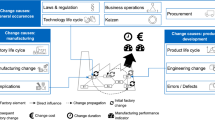Abstract
Engineering change (EC) is common in the aviation industry, which affects the production efficiency and the stability of a manufacturing system as a frequent disturbance. The way how to respond to EC in manufacturing execution processes is one of the most important and complex issue in manufacturing industries. And the prime step for manufacturing department to accomplish EC efficiently is to detect and identify changes correctly and in time. According to special features of the aviation industry, engineering bill of material (EBOM) and manufacturing BOM (MBOM) models are proposed to save EC information accurately and timely by using version vectors to record version information. EC may affect the production process directly by those changed items, but it can make a potential impact on some related items. The EC propagation mechanism is described to collect all the items impacted by EC. The method of Tree-Root tracking and the ripple strategy of expand searching with capacity restriction are explained by a composite material manufacturing case. It figures out the range of impact of EC which may help to point out what, where, and when need to rearrange the schedule in order to optimizing the implement of EC especially after manufacturing commences. The approach was proved to be practical with a case of aviation carbon fiber composite material components.
Similar content being viewed by others
References
Jarratt TAW, Eckert CM, Caldwell NHM, Clarkson PJ (2011) Engineering change: an overview and perspective on the literature. Res Eng Des 22(2):103–124
Huang GQ, Lee WY, Mak KL (2003) Current practice of engineering change management in Hong Kong manufacturing industries. J Mater Process Technol 139:481–487
Angers S (2002) Changing the rules of the ‘Change’ game—employees and suppliers work together to transform the 737/757 production system. Boeing Front 1(1)
Xu L (2011) Information architecture for supply chain quality management. Int J Prod Res 49(1):183–198
Wang C, Xu L (2008) Parameter mapping and data transformation for engineering application integration. Inf Syst Front 10(5):589–600
Jarratt TAW, Eckert CM, Clarkson PJ (2004) Development of a product model to support engineering change management. In: Proceedings of TMCE 2004, Lausanne, Switzerland, 1:331–342
Wynn DC, Eckert CM, Clarkson PJ (2007) Modelling iteration in engineering design. In: Bocquet J-C (ed) Proceedings of the 16th International Conference on Engineering Design (ICED’07), Paris, France, pp 693–694
Ji J, Zhang D, Li S (2011) Configuration management and change control method for civil aircraft engine. Comput Integr Manuf Syst CIMS 17(11):2514–2525
Shan S, Wang L, Xin T et al (2012) Developing a rapid response production system for aircraft manufacturing. Int J Prod Econ
Fricke E, Gebhard B, Negele H, Igenbergs E (2000) Coping with changes: causes, findings and strategies. Syst Eng 3(4):169–179
Clarkson PJ, Simons C, Eckert CM (2004) Predicting change propagation in complex design, vol 126. ASME design engineering technical conferences, Pittsburgh
Eckert CM, Clarkson PJ, Zanker W (2004) Change and customization in complex engineering domains. Res Eng Des 15(1):1–21
Terwiesch C, Loch CH (1999) Managing the process of engineering change orders: the case of the climate control system in automobile development. J Prod Innov Manag 16(2):160–172
Mo R, Gong ZW, Yang H, Zhang X (2012) The detection of avalanche propagation in engineering change. Appl Mech Mater 121-126:3578–3582, Frontiers of Manufacturing and Design Science II
Quintana V, Rivest L, Pellerin R, Kheddouci F (2012) Re-engineering the engineering change management process for a drawing-less environment. Comput Ind 63(1):79–90
Kocar V, Akgunduz A (2010) ADVICE: a virtual environment for engineering change management. Comput Ind 61(1):15–28
Ma S, Song B, Lu WF, Zhu CF, A knowledge-supported system for engineering change impact analysis. ASME 2003 International Design Engineering Technical Conferences, Chicago, Illinois, USA, September 2–6, 2003, Paper No. DETC2003/DAC-48749, pp 439–447
Lee HJ, Ahn HJ, Kim JW, Park SJ (2006) Capturing and reusing knowledge in engineering change management: a case of automobile development. Inf Syst Front 8:375–394
Habhouba D, Cherkaoui S, Desrochers A (2011) Decision-making assistance in engineering-change management process. IEEE Trans Syst Man Cybern Part C Appl Rev 41(3):344–349
FEI G, Gao J, Owodunni D, Tang X (2011) A model-driven and knowledge-based methodology for engineering design change management. Comput Aided Des Applic 8(3):373–382
Zeng F, Zhou L, Li Z (2011) Study on degree of engineering changes based on product family. Adv Mater Res 201-203:572–576
Tang D, Xu R, Tang J, He R (2010) Analysis of engineering change impacts based on design structure matrix. J Mech Eng 46(1):154–160 (in Chinese)
Tang D, Xu R, Tang J, He R (2008) Design structure matrix-based engineering change management for product development. Int J Internet Manuf Serv 1(3):231–245
Wang B, Ye W (2011) Study on production scheduling method of reentrant bottlenecking equipment of aeronautical composite materials. Manuf Inf Eng China 40(11):57–60, 63,(in Chinese)
Author information
Authors and Affiliations
Corresponding author
Rights and permissions
About this article
Cite this article
Leng, S., Wang, L., Chen, G. et al. Engineering change information propagation in aviation industrial manufacturing execution processes. Int J Adv Manuf Technol 83, 575–585 (2016). https://doi.org/10.1007/s00170-015-7612-2
Received:
Accepted:
Published:
Issue Date:
DOI: https://doi.org/10.1007/s00170-015-7612-2




